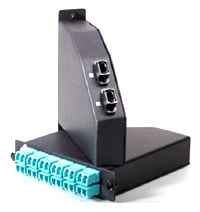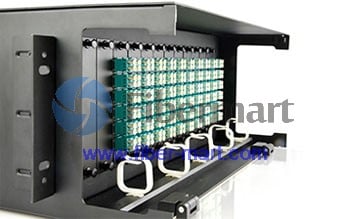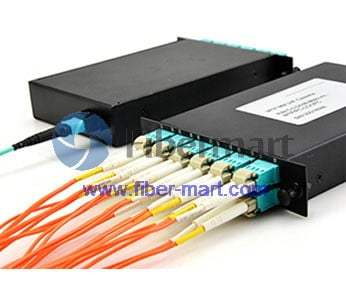by www.fiber-mart.com
FTTH makes use of Fiber Optic technology to enhance communication for households. FTTH stands for Fiber to the Home, and many experts believe that
FTTH cable will soon replace the traditional copper cables. There are various other elements of FTTH. FTTH Flat Drop Cable is generally also known as indoor cable. Other elements of the technology include instrumentation cables and cable glands. Next let us make a brief introduction of cable construction and the difference of Loose-Tube and Tight-Buffer Cable.
Optical-Cable Construction
The core is the highly refractive central region of an optical fiber through which light is transmitted. The standard telecommunications core diameter in use with SMF is between 8 m and 10m, whereas the standard core diameter in use with MMF is between 50m and 62.5m. The diameter of the cladding surrounding each of these cores is125m. Core sizes of 85m and 100 m were used in early applications, but are not typically used today. The core and cladding are manufactured together as a single solid component of glass with slightly different compositions and refractive indices. The third section of an optical fiber is the outer protective coating known as the coating. The coating is typically an ultraviolet (UV) light-cured acrylate applied during the manufacturing process to provide physical and environmental protection for the fiber. The buffer coating could also be constructed out of one or more layers of polymer, nonporous hard elastomers or high-performance PVC materials. The coating does not have any optical properties that might affect the propagation of light within the Breakout Fiber Optic Cable. During the installation process, this coating is stripped away from the cladding to allow proper termination to an optical transmission system. The coating size can vary, but the standard sizes are 250m and 900m. The 250- m coating takes less space in larger outdoor cables. The 900- m coating is larger and more suitable for smaller indoor cables.
Three types of material make up fiber-optic cables:
• Glass
• Plastic
• Plastic-clad silica (PCS)
These three cable types differ with respect to attenuation. Attenuation is principally caused by two physical effects: absorption and scattering. Absorption removes signal energy in the interaction between the propagating light (photons) and molecules in the core. Scattering redirects light out of the core to the cladding. When attenuation for a fiber-optic cable is dealt with quantitatively, it is referenced for operation at a particular optical wavelength, a window, where it is minimized. The most common peak wavelengths are 780 nm, 850 nm, 1310 nm, 1550 nm, and 1625 nm. The 850-nm region is referred to as the first window (as it was used initially because it supported the original LED and detector technology). The 1310-nm region is referred to as the second window, and the 1550-nm region is referred to as the third window.
Glass Fiber-Optic Cable
Glass fiber-optic cable has the lowest attenuation. A pure-glass, fiber-optic cable has a glass core and a glass cladding. This cable type has, by far, the most widespread use. It has been the most popular with link installers, and it is the type of cable with which installers have the most experience. The glass used in a fiber-optic cable is ultra-pure, ultra-transparent, silicon dioxide, or fused quartz. During the glass fiber-optic cable fabrication process, impurities are purposely added to the pure glass to obtain the desired indices of refraction needed to guide light. Germanium, titanium, or phosphorous is added to increase the index of refraction. Boron or fluorine is added to decrease the index of refraction. Other impurities might somehow remain in the glass cable after fabrication. These residual impurities can increase the attenuation by either scattering or absorbing light.
Plastic Fiber-Optic Cable
Plastic fiber-optic cable has the highest attenuation among the three types of cable. Plastic fiber-optic cable has a plastic core and cladding. This fiber-optic cable is quite thick. Typical dimensions are 480/500, 735/750, and 980/1000. The core generally consists of polymethylmethacrylate (PMMA) coated with a fluoropolymer. Plastic Fiber Optic cable was pioneered principally for use in the automotive industry. The higher attenuation relative to glass might not be a serious obstacle with the short cable runs often required in premise data networks. The cost advantage of plastic fiber-optic cable is of interest to network architects when they are faced with budget decisions. Plastic fiber-optic cable does have a problem with flammability. Because of this, it might not be appropriate for certain environments and care has to be taken when it is run through a plenum. Otherwise, plastic fiber is considered extremely rugged with a tight bend radius and the capability to withstand abuse.
Plastic-Clad Silica (PCS) Fiber-Optic Cable
The attenuation of PCS fiber-optic cable falls between that of glass and plastic. PCS Fiber Optic Cable has a glass core, which is often vitreous silica, and the cladding is plastic, usually a silicone elastomer with a lower refractive index. PCS fabricated with a silicone elastomer cladding suffers from three major defects. First, it has considerable plasticity, which makes connector application difficult. Second, adhesive bonding is not possible. And third, it is practically insoluble in organic solvents. These three factors keep this type of fiber-optic cable from being particularly popular with link installers. However, some improvements have been made in recent years.
FTTH (Fiber to the Home) network compared with technologies now used in most places increases the connection speeds available for residences, apartment building and enterprises. FTTH network is the installation and use of optical fiber from a central point known as an access node to individual buildings. The links between subscriber and access node are achieved by fiber jumper cables. Loose-tube and tight buffer cables are commonly used to transmit signals with high speed, which are capable of supporting outdoor or indoor environment. Is there a cost-effective solution that can support both indoor and outdoor environment in FTTH network? To answer this, the construction and comparison of loose tube cable and tight buffer cable will be introduced in the following article.
Loose-Tube and Tight-Buffer Cable
The “buffer” in tight buffer cable refers to a basic component of fiber optic cable, which is the first layer used to define the type of cable construction. Typically a fiber optic cable consists of the optical fiber, buffer, strength members and an outer protective jacket (as showed in Figure 1). Loose-tube and tight-buffer cables are two basic cable design. Loose-tube cable is used in the majority of outside-plant installations, and tight-buffered cable, primarily used inside buildings.
Loose-tube and tight-buffer cables
Loose-tube cable consists of a buffer layer that has an inner diameter much larger than the diameter of the fiber see in the following picture. Thus, the cable will be subject to temperature extremes in the identification and administration of fibers in the system. That’s why Loose Tube CST Fibre Cable are usually used in outdoor application. The loose-tube cables designed for FTTH outdoor application are usually loose-tube gel-filled cables (LTGF cable). This type of cable is filled with a gel that displaces or blocks water and prevents it from penetrating or getting into the cable.Tight buffer cable using a buffer attached to the fiber coating is generally smaller in diameter than loose buffer cable (showed in Figure 2). The minimum bend radius of a tight buffer cable is typically smaller than a comparable loose buffer cable. Thus tight buffer cable is usually used in indoor application.
loose buffer cable
Tight buffered indoor/outdoor cable with properly designed and manufactured can meet both indoor and outdoor application requirements. It combines the design requirements of traditional indoor cable and adds moisture protection and sunlight-resistant function to meet the standards for outdoor use. Tight buffered indoor/outdoor cable also meets one or more of the code requirements for flame-spread resistance and smoke generation.
In short, FTTH cable is transforming the way we communicated in the past; and it will soon become the norm. FTTH network can be increased reoffers high quality fiber cable assemblies such as Patch Cords, Pigtails, MCPs, and Breakout Cables etc. All of our custom fiber patch cords can be ordered as Single Mode 9/125, Multimode 62.5/125 OM1, and Multimode 50/125 OM2 and Multimode 10 Gig 50/125 OM3/OM4 fibers. If you have any requirement, please send your request to us.







